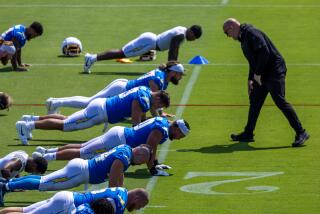Some GIs Trained in Harsh Mojave
- Share via
For many of the American troops dispatched to the Middle East to counter the Iraqi threat, the sunbaked sands of Saudi Arabia--extreme as conditions there are certain to be--will not seem entirely unfamiliar.
Thirty miles northeast of Barstow, in a remote, bone-dry region that resembles a moonscape, lies the Army’s National Training Center at Ft. Irwin. Here, amid swirling sand and craggy ridges, the Pentagon has tried to give thousands of soldiers a first taste of the harsh realities of desert warfare.
Year in, year out, brigades from across the country come to the Mojave Desert post to train in 14-day rotations. In temperatures that routinely soar past 100 in summertime, troops fan out across Ft. Irwin’s 1,000 square miles, plotting and fighting mock wars against a resident, Soviet-style force on barren battlefields dubbed the “Valley of Death” and “Siberia.”
Created in 1981 in response to the changing nature of war, the training center allows the sort of large-scale maneuvers not possible on smaller posts. Army commanders design the scrimmages--which include tanks, aircraft and tear gas to simulate chemical warfare--to apply to any potential fighting environment, and most scenarios envision an East-West conflict.
But Ft. Irwin’s location in the Mojave means that troops emerge with a keen understanding of the desert and its threat to their performance in battle.
“From soldier to commander, when you are here at the National Training Center, you must learn to take the environment into account,” said spokesman Maj. John Wagstaffe. “We’re teaching combat skills. But the weather, the desert terrain--these are conditions you must understand to execute your mission.”
The desert’s interference with that mission starts with the reduced energy level of overheated soldiers, particularly those from cooler climates who are unaccustomed to the harm that high temperatures can inflict on the ill-prepared.
“The first and foremost rule is the consumption of water--lots of water, up to several gallons a day,” said Lt. Col. Greg Camp, a former battalion commander who now coaches visiting units at Ft. Irwin. “Heat exhaustion and dehydration are real-world injuries the chain of command has to deal with and plan for. . . . And carrying large bulks of water can create logistical problems we must prepare them for.”
Even with adequate water, a soldier’s performance is hindered by the heat, Camp said. Commanders, he said, learn to keep an eye on their troops and deploy them on tasks of short durations while providing generous rests.
The perils of the desert extend to equipment as well. Sand and dust require soldiers to check and clean their weapons daily, and the air filters on tanks, Bradley fighting vehicles and trucks can become clogged without frequent attention.
Extreme heat can limit the lift capability of helicopters and other aircraft, and the fierce winds that whip across the desert create sandstorms that limit visibility and make flying dangerous.
Ft. Irwin also trains soldiers in the special techniques needed for effective camouflage and concealment in the desert’s stark landscape. Unlike jungle and forest battle sites, the desert offers little obvious opportunity for cover.
“The . . . disadvantages become apparent to the visiting soldiers very quickly,” Camp said. “Here, concealment is based on a very keen analysis of the terrain and finding things like waddies and gullies and using the sides of mountains to move so you are obscured by shadows.”
More to Read
Sign up for Essential California
The most important California stories and recommendations in your inbox every morning.
You may occasionally receive promotional content from the Los Angeles Times.













